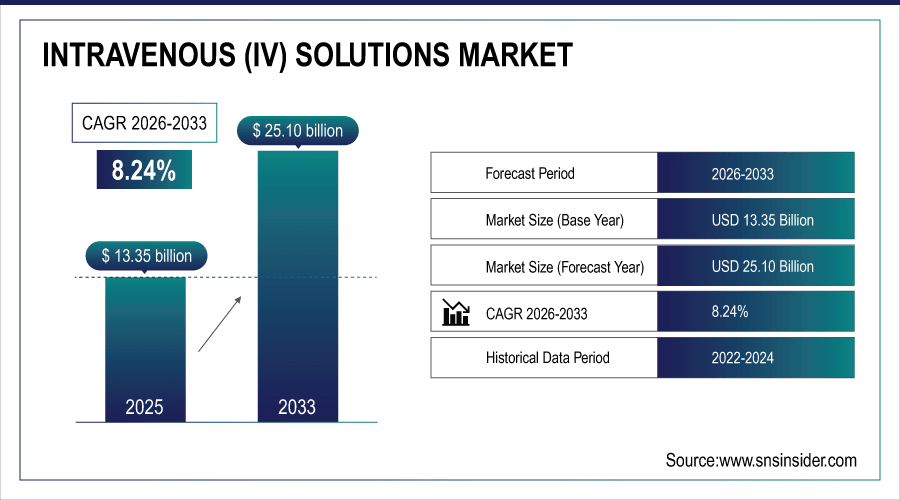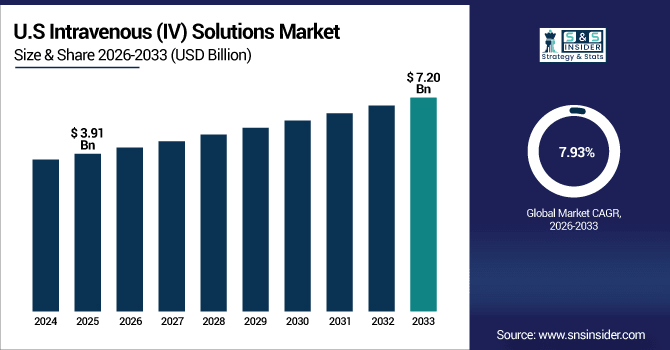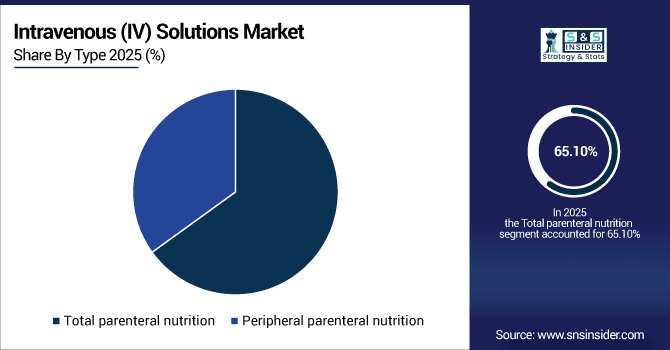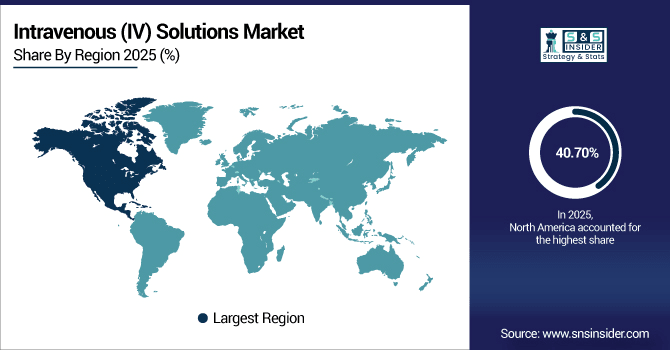Intravenous (IV) Solutions Market Report Scope & Overview:
The Intravenous (IV) Solutions Market Size was valued at USD 13.35 Billion in 2025E and is expected to reach USD 25.10 Billion by 2033 and grow at a CAGR of 8.24% over the forecast period 2026-2033.
The Intravenous (IV) Solutions Market analysis, driven by the rising prevalence of chronic diseases and critical care conditions such as cancer, cardiovascular disorders, malnutrition, and dehydration. Increasing hospital admissions, surgical procedures, and the demand for parenteral nutrition in both pediatric and geriatric populations have significantly boosted the consumption of IV solutions. According to study, Hospital-based IV usage is growing at a yearly rate of 6–7% due to increasing admissions and surgical procedures.

To Get More Information On Intravenous (IV) Solutions Market - Request Free Sample Report
Market Size and Forecast:
-
Market Size in 2025: USD 13.35 Billion
-
Market Size by 2033: USD 25.10 Billion
-
CAGR: 8.24% from 2026 to 2033
-
Base Year: 2025
-
Forecast Period: 2026–2033
-
Historical Data: 2022–2024
Intravenous (IV) Solutions Market Trends
-
Growing chronic disease prevalence increases reliance on intravenous therapy in hospitals.
-
Rising surgeries and critical care needs drive higher IV solutions consumption.
-
Paediatric and geriatric patient populations boost parenteral nutrition demand globally.
-
Expansion of home healthcare increases adoption of portable and user-friendly IV devices.
-
Pre-mixed and easy-to-administer IV solutions enhance treatment efficiency and patient safety.
-
Remote and outpatient IV therapy adoption creates new growth opportunities for manufacturers.
U.S. Intravenous (IV) Solutions Market Insights:
The U.S. Intravenous (IV) Solutions Market size was USD 3.91 Billion in 2025E and is expected to reach USD 7.20 Billion by 2033, growing at a CAGR of 7.93% over the forecast period of 2026-2033, driven by advanced healthcare infrastructure, high adoption of innovative IV therapies, strong hospital networks, and growing demand for nutritional support, fluid management, and critical care across hospitals and home healthcare settings.

Intravenous (IV) Solutions Market Growth Drivers:
-
Rising Chronic Diseases Accelerate Demand for Intravenous Solutions Worldwide Rapidly
Intravenous (IV) Solutions Market growth is due to incidence of chronic diseases such as cancer, cardiovascular disorders, kidney failure, and malnutrition is a primary driver for the IV Solutions Market. Patients with these conditions often require parenteral nutrition, fluid replacement, and electrolyte balance, which can only be administered effectively via intravenous solutions. Increasing hospital admissions, surgeries, and critical care requirements for paediatric and geriatric populations further fuel demand. Healthcare providers are increasingly relying on IV therapy as a standardized treatment, making it a major growth driver for the market.
In Gaza, over 54,600 children under 5 are acutely malnourished, with more than 12,800 severely affected, underscoring the need for IV nutrition support.
Intravenous (IV) Solutions Market Restraints:
-
Contamination Risks and Adverse Reactions Challenge IV Solutions Market Growth
The market faces restraints due to the risk of contamination, infections, and adverse reactions associated with improper handling or administration. Contaminated IV solutions can lead to bloodstream infections, sepsis, or severe complications, especially in immunocompromised patients. This risk has prompted strict regulatory guidelines and quality checks, which can increase manufacturing costs and slow down product distribution. Hospitals and home care providers must invest in training, sterilization, and monitoring systems, which can restrict rapid market growth in certain regions.
Intravenous (IV) Solutions Market Opportunities:
-
Home Healthcare Expansion Unlocks Lucrative Market for Portable IV Solutions
The increasing adoption of home healthcare and outpatient IV therapy presents a significant opportunity for market expansion. Patients now prefer receiving IV therapy in the comfort of their homes, reducing hospital stays and associated costs. Companies can capitalize on this by developing portable IV infusion devices, pre-mixed solutions, and user-friendly administration kits, enabling easier self-administration and remote monitoring. The growing home care IV market represents a lucrative growth avenue for manufacturers.
Over 60% of patients express preference for receiving IV therapy at home to reduce hospital visits and associated costs.
Intravenous (IV) Solutions Market Segmentation Analysis:
-
By Type: In 2025, Total parenteral nutrition led the market with a share of 65.10%, while Peripheral parenteral nutrition is the fastest-growing segment with a CAGR of 8.90%.
-
By Composition: In 2025, Parenteral lipid emulsion led the market with a share of 32.60%, while Single-dose amino acids is the fastest-growing segment with a CAGR of 9.20%.
-
By Application: In 2025, Nutritional support led the market with a share of 55.60%, while Fluid and electrolyte balance is the fastest-growing segment with a CAGR of 8.70%.
-
By End Use: In 2025, Hospitals and clinics led the market with a share of 70.20%, while home care settings is the fastest-growing segment with a CAGR of 9.50%.
By Type, Total parenteral nutrition Lead Market and Peripheral parenteral nutrition Fastest Growth
The Total parenteral nutrition leads the market in 2025, due to its extensive use in hospitals, clinics, and home care settings for patients requiring complete nutritional support. Its widespread adoption is driven by increasing prevalence of chronic illnesses, post-surgical recovery needs, and critical care requirements. Meanwhile, Peripheral parenteral nutrition is the fastest-growing segment, supported by rising awareness of targeted, short-term nutritional therapies, convenience of peripheral administration, and growing adoption in ambulatory and home healthcare facilities.

By Composition, Parenteral lipid emulsion Lead Market and Single-dose amino acids Fastest Growth
The Parenteral lipid emulsion leads the market in 2025, due to its essential role in providing high-calorie nutritional support to critically ill and malnourished patients. Its extensive use in hospitals and clinics is driven by the increasing demand for complete parenteral nutrition formulations. Meanwhile, Single-dose amino acids represent the fastest-growing segment, fueled by the rising need for precise, patient-specific amino acid supplementation, ease of administration, and growing adoption in home healthcare and specialty medical facilities.
By Application, Nutritional support Lead Market and Fluid and electrolyte balance Fastest Growth
The Nutritional support leads the market in 2025, due to the growing prevalence of chronic diseases, malnutrition, post-surgical recovery needs, and critical care requirements. Hospitals and clinics extensively use nutritional IV solutions to provide complete patient support, driving steady demand. Meanwhile, Fluid and electrolyte balance is the fastest-growing application segment, supported by increasing cases of dehydration, electrolyte imbalances, and critical care interventions, along with rising awareness of preventive and supportive intravenous therapies in ambulatory and home care settings.
By End Use, Hospitals and clinics Lead Market and Home care settings Fastest Growth
The Hospitals and clinics lead the market in 2025, due to the high demand for IV solutions in critical care, surgical procedures, and chronic disease management. Hospitals and clinics remain the primary users because of their well-established infrastructure, trained medical staff, and the need for continuous patient monitoring. Meanwhile, Home care settings represent the fastest-growing segment, driven by the increasing preference for at-home treatment, rising awareness of home-based healthcare services, and the convenience of administering IV therapy outside traditional medical facilities.
Intravenous (IV) Solutions Market Regional Analysis:
North America Intravenous (IV) Solutions Market Insights:
The North America dominated the Intravenous (IV) Solutions Market in 2025E, with over 40.70% revenue share, driven by advanced healthcare infrastructure, high prevalence of chronic and critical illnesses, and strong government healthcare funding. Hospitals and clinics dominate IV solution consumption, supported by well-established protocols for nutritional support, fluid management, and critical care. The region benefits from rapid adoption of advanced IV technologies, including pre-mixed solutions, smart infusion pumps, and automated compounding systems. Additionally, increasing awareness of home healthcare and outpatient IV therapy is expanding the market.

Get Customized Report as Per Your Business Requirement - Enquiry Now
U.S. Intravenous (IV) Solutions Market Insights
The U.S. and Canada lead the Intravenous (IV) Solutions market due to advanced healthcare infrastructure, high adoption of innovative IV technologies, strong hospital networks, and substantial healthcare expenditure. Widespread use in critical care, surgical procedures, and home healthcare, combined with supportive government policies, drives consistent market dominance in the region.
Asia Pacific Intravenous (IV) Solutions Market Insights:
The Asia-Pacific region is expected to have the fastest-growing CAGR 9.46%, driven by rising healthcare expenditure, expanding hospital and clinic infrastructure, and increasing awareness of advanced IV therapies. The demand for nutritional support, fluid management, and critical care applications is growing rapidly due to a rising patient population and increasing prevalence of chronic illnesses. Adoption of pre-mixed solutions, smart infusion pumps, and home-based IV therapy is accelerating. Strategic investments by key market players in distribution, manufacturing, and technological advancements are further fueling market growth across healthcare facilities and home care settings throughout the region.
China and India Intravenous (IV) Solutions Market Insights
China and India are the fastest-growing markets for Intravenous (IV) Solutions due to increasing healthcare investment, expanding hospital and clinic infrastructure, and rising awareness of IV therapies. Growing patient populations, higher prevalence of chronic illnesses, and the adoption of home-based and advanced IV solutions further accelerate market growth in these regions.
Europe Intravenous (IV) Solutions Market Insights
Europe represents a significant market for Intravenous (IV) Solutions, by high adoption of advanced healthcare technologies and strong hospital infrastructure. Hospitals and clinics dominate IV solution consumption, driven by increasing demand for nutritional support, fluid and electrolyte management, and critical care applications. The region benefits from ongoing investments in pre-mixed IV formulations, smart infusion systems, and automated compounding technologies. Additionally, growing awareness of home-based IV therapy is gradually expanding market presence beyond traditional healthcare facilities.
Germany and U.K. Intravenous (IV) Solutions Market Insights
The U.K. and Germany are growing in the Intravenous (IV) Solutions market due to well-established healthcare systems, increasing demand for nutritional support and critical care, and adoption of advanced IV technologies. Investments in hospital infrastructure, home healthcare services, and government initiatives supporting patient care further drive steady market expansion.
Latin America (LATAM) and Middle East & Africa (MEA) Intravenous (IV) Solutions Market Insights
The Latin America (LATAM) and Middle East & Africa (MEA) Intravenous (IV) Solutions Market are emerging regions showing steady growth, driven by improving healthcare infrastructure, rising awareness of advanced IV therapies, and increasing demand for nutritional support, fluid management, and critical care applications. Hospitals and clinics remain the primary consumers, while home care settings are gradually gaining traction. Market expansion is supported by strategic initiatives from key players, including investments in distribution networks, technological advancements, and training programs for healthcare professionals.
Intravenous (IV) Solutions Market Competitive Landscape
B. Braun Melsungen AG is a leading contributor to the IV Solutions Market, emphasizing safe and user-friendly products. Its DEHP-free and PVC-free solutions, certified by Nurse Approved standards, ensure patient safety and ease of use. The company’s continuous focus on innovation, quality, and compliance drives adoption across hospitals, clinics, and emerging home healthcare applications, solidifying its market leadership.
-
In September 2025, B. Braun received the Nurse Approved Certification for its entire IV Solutions portfolio not made with DEHP or PVC, Plastic Irrigation Containers, and Piperacillin and Tazobactam in DUPLEX® Drug Delivery System, highlighting its commitment to excellence in usability and alignment with nursing practice needs.
ICU Medical, Inc. plays a significant role in the IV Solutions Market with its precision infusion pumps and collaborative ventures. FDA-cleared devices like Plum Solo and Plum Duo enhance accuracy and compatibility with various therapies. Strategic partnerships with global players expand production capacity and distribution, enabling ICU Medical to address growing demand in critical care, home care, and hospital settings worldwide.
-
In April 2025, ICU Medical introduced its new category of infusion devices with FDA clearances of Plum Solo and Plum Duo precision IV pumps, offering ±3% accuracy and compatibility with whole blood and blood products.
Terumo Corporation has strengthened its position in the IV Solutions Market through the launch of innovative injection filter needles and advanced IV infusion devices. The company focuses on improving safety, precision, and patient convenience, catering to hospitals, clinics, and home care. Its technological advancements and strategic initiatives support market growth and adoption of modern IV therapies globally.
-
In January 2025, Terumo launched its Injection Filter Needle, the first step of the INFINO™ Development Program, to extend the choice for hypodermic and intravitreal injections.
Intravenous (IV) Solutions Market Key Players:
Some of the Intravenous (IV) Solutions Market Companies are:
-
Baxter International Inc.
-
B. Braun Melsungen AG
-
Fresenius Kabi AG
-
Grifols, S.A.
-
ICU Medical, Inc.
-
Otsuka Pharmaceutical Co., Ltd.
-
Ajinomoto Co., Inc.
-
Terumo Corporation
-
Pfizer Inc.
-
Hospira, Inc.
-
Daiichi Sankyo Company, Limited
-
Hikma Pharmaceuticals PLC
-
Cardinal Health, Inc.
-
Abbott Laboratories
-
Novartis AG
-
Medline Industries, Inc.
-
Chongqing Huapont Pharm Co., Ltd.
-
Shanghai Fuxing Pharmaceutical Co., Ltd.
-
Taisho Pharmaceutical Co., Ltd.
-
CJ Healthcare Corporation
| Report Attributes | Details |
|---|---|
| Market Size in 2025E | USD 13.35 Billion |
| Market Size by 2033 | USD 25.10 Billion |
| CAGR | CAGR of 8.24% From 2026 to 2033 |
| Base Year | 2025E |
| Forecast Period | 2026-2033 |
| Historical Data | 2022-2024 |
| Report Scope & Coverage | Market Size, Segments Analysis, Competitive Landscape, Regional Analysis, DROC & SWOT Analysis, Forecast Outlook |
| Key Segments | • By Type (Total parenteral nutrition, Peripheral parenteral nutrition) • By Composition (Carbohydrates, Vitamins and minerals, Single-dose amino acids, Parenteral lipid emulsion, Other compositions) • By Application (Nutritional support, Blood transfusion, Fluid and electrolyte balance, Other applications) • By End Use (Hospitals and clinics, Ambulatory surgery centers, Home care settings) |
| Regional Analysis/Coverage | North America (US, Canada), Europe (Germany, UK, France, Italy, Spain, Russia, Poland, Rest of Europe), Asia Pacific (China, India, Japan, South Korea, Australia, ASEAN Countries, Rest of Asia Pacific), Middle East & Africa (UAE, Saudi Arabia, Qatar, South Africa, Rest of Middle East & Africa), Latin America (Brazil, Argentina, Mexico, Colombia, Rest of Latin America). |
| Company Profiles | Baxter International Inc., B. Braun Melsungen AG, Fresenius Kabi AG, Grifols S.A., ICU Medical, Inc., Otsuka Pharmaceutical Co., Ltd., Ajinomoto Co., Inc., Terumo Corporation, Pfizer Inc., Hospira, Inc., Daiichi Sankyo Company, Limited, Hikma Pharmaceuticals PLC, Cardinal Health, Inc., Abbott Laboratories, Novartis AG, Medline Industries, Inc., Chongqing Huapont Pharm Co., Ltd., Shanghai Fuxing Pharmaceutical Co., Ltd., Taisho Pharmaceutical Co., Ltd., CJ Healthcare Corporation., and Others. |

